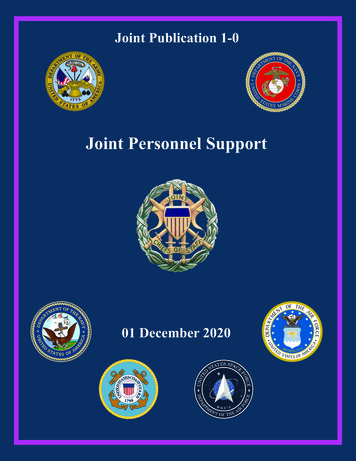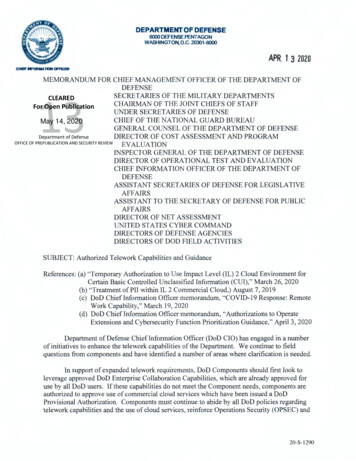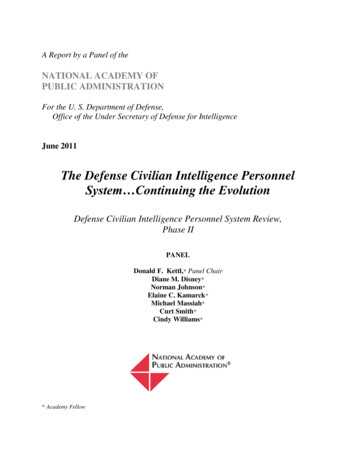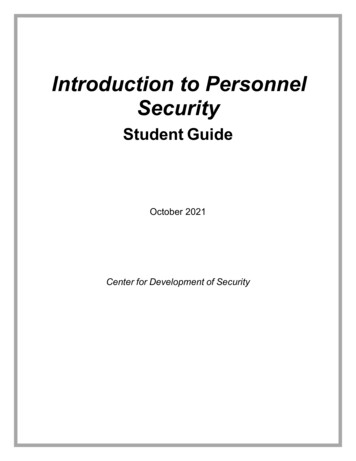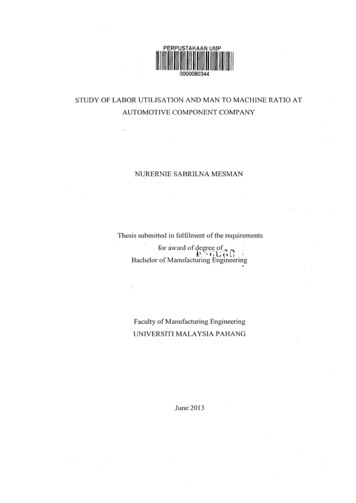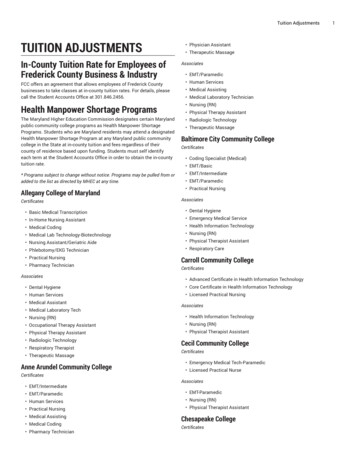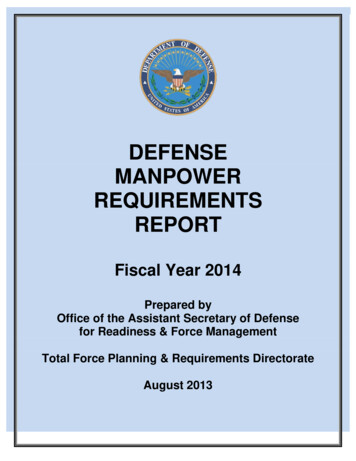
Transcription
DEFENSEMANPOWERREQUIREMENTSREPORTFiscal Year 2014Prepared byOffice of the Assistant Secretary of Defensefor Readiness & Force ManagementTotal Force Planning & Requirements DirectorateAugust 2013
TABLE OF CONTENTSPREFACE . IVIntroduction. ivOrganization of the Report . ivManpower Requirements Overview . ivThe Total Force . vCHAPTER 1: DEPARTMENT OVERVIEW. 1Table 1-1: Department of Defense Manpower Totals . 2Table 1-2a: Active Military Manpower Totals by Personnel Category . 3Table 1-2b: Selected Reserve Military Manpower Totals by Personnel Category . 3Table 1-3: Major Military Force Units . 4Table 1-4: Active Military Manpower in Units and Individuals Account . 5CHAPTER 2: SERVICE AND DEFENSE-LEVEL SUMMARIES . 6Table 2-1a: Army Military and Civilian Manpower by Force and Infrastructure Category . 7Table 2-1b: Navy Military and Civilian Manpower by Force and Infrastructure Category. 8Table 2-1c: Marine Corps Military and Civilian Manpower by Force and Infrastructure Category . 9Table 2-1d: Air Force Military and Civilian Manpower by Force and Infrastructure Category . 10Table 2-2: Military Technicians Assigned, Authorized, and Required by Status and Organization . 11Table 2-3: Full-Time Support to the Selected Reserves . 12Table 2-4: Manpower in Defense-Level Activities and Accounts . 13Table 2-5: Service-Level Manpower Required to be Stationed in Foreign Countries and Ships Afloat . 16Table 2-6: Major Headquarters Activities . . .17CHAPTER 3: OFFICER AND ENLISTED FLOW DATA . 19Table 3-1a:Table 3-1b:Table 3-1c:Table 3-1d:Table 3-2a:Table 3-2b:Table 3-2c:Table 3-2d:Table 3-3a:Table 3-3b:Table 3-3c:Table 3-3d:Table 3-4a:Table 3-4b:Table 3-4c:Table 3-4d:Army Active Duty Officer Gains and Losses . 20Navy Active Duty Officer Gains and Losses . 23Marine Corps Duty Officer Gains and Losses . 26Air Force Active Duty Officer Gains and Losses . 29Army Active Duty Officer Retirements by YOCS . 32Navy Active Duty Officer Retirements by YOCS . 35Marine Corps Active Duty Officer Retirements by YOCS . 38Air Force Active Duty Officer Retirements by YOCS . 41Army Active Duty Enlisted Gains and Losses . 44Navy Active Duty Enlisted Gains and Losses . 47Marine Corps Active Duty Enlisted Gains and Losses . 50Air Force Active Duty Enlisted Gains and Losses . 53Active Duty Army Enlisted Member Retirements by YOS . 56Active Duty Navy Enlisted Member Retirements by YOS . 59Active Duty Marine Corps Enlisted Member Retirements by YOS . 62Active Duty Air Force Enlisted Member Retirements by YOS . 65CHAPTER 4: DIVERSITY DEMOGRAPHIC DATA . 67Table 4-1a: Army Active Duty Demographic Data . 69Table 5-1b: Navy Active Duty Demographic Data . 70i
Table 4-1c:Table 4-1d:Table 4-1e:Table 4-2a:Table 4-2b:Table 4-2c:Table 4-2d:Table 4-2e:Table 4-3a:Table 4-3b:Table 4-3c:Table 4-3e:Table 4-4a:Table 4-4b:Table 4-4b:Table 4-4b:Table 4-5a:Table 4-5b:Table 4-5c:Table 4-5d:Table 4-6a:Table 4-6b:Table 4-6c:Table 4-6d:Table 4-6e:Table 4-6f:Table 4-6g:Table 4-6h:Marine Corps Active Duty Demographic Data . 71Air Force Active Duty Demographic Data . 72DoD Active Duty Demographic Data . 73Army Selected Reserve Demographic Data . 74Navy Selectede Reserve Demographic Data . 77Marine Corps Selected Reserve Demographic Data . 78Air Force Selected Reserve Duty Demographic Data . 79DoD Selected Reserve Demographic Data . 82Army Active Duty Promotion Dempgraphics . 83Navy Active Duty Promotion Demographics . 84Marine Corps Active Duty Promotion Demographics . 85Air Force Active Duty Promotion Demographics . 86Army Selected Reserve Promotion Demographics . 87Navy Selected Reserve Promotion Demographics . 89Marine Corps Selected Reserve Promotion Demographics . 90Air Force Selected Reserve Promotion Demographics . 91Army Active Duty Reenlistment and Extension Demographics . 93Navy Active Duty Reenlistment and Extension Demographics . 93Marine Corps Active Duty Reenlistment and Extension Demographics . 94Air Force Active Duty Reenlistment and Extension Demographics . 94Army Selected Reserve Reenlistment Demographics . 95Navy Selected Reserve Reenlisment Demographics . 96Marine Corps Selected Reserve Reenlisment Demographics . 96Air Force Selected Reserve Reenlisment Demographics . 97Army Selected Reserve Extension Demographics . 98Navy Selected Reserve Extension Demographics . 99Marine Corps Selected Reserve Extension Demographics . 99Air Force Selected Reserve Extension Demographics . 100CHAPTER 5: MEDICAL MANPOWER REQUIREMENTS . 101Table 5-1: DoD Medical Manpower Program. 102Table 5-1a: Army Medical Manpower Program . 102Table 5-1b: Navy Medical Manpower Program. 103Table 5-1c: Air Force Medical Manpower Program . 103CHAPTER 6: INVENTORY OF CONTRACTS FOR SERVICES . 104Table 6-1: Results of FY2010 Inventory of Contracts for Services . 104Table 6-2: Results of FY2011 Inventory of Contracts for Services . 105CHAPTER 7: MANPOWER REQUEST JUSTIFICATIONS . 106Army Manpower Request . 106Introduction. 106Military Manpower . 107Civilian Manpower: . 107Navy Manpower Request . 109Introduction. 109Key Manpower Issues . 109Conclusion. 111ii
Marine Corps Manpower Request. 112Introduction. 112Active Component . 113Reserve Component . 114Civilian Manpower . 115Air Force Manpower Request . 116Introduction. 116Active Component . 117Reserve Component . 117Civilian Manpower . 118Conclusion. 118iii
PrefaceIntroductionThe Department of Defense hereby provides the Defense Manpower RequirementsReport (DMRR) for fiscal year (FY) 2014 in compliance with Section 115a of Title 10, UnitedStates Code (U.S.C.). This report should be used in conjunction with the FY2014 Budget.Organization of the ReportThis report explains the Department of Defense (DoD) manpower requirementsincorporated in the President's Budget for FY2014. The report is organized into seven chapters. Chapter 1 contains an overview of the total number of Defense-wide personnel bothmilitary and civilian. It provides a clear and succinct picture of manpower in theDepartment and provides the basis for the rest of this report.Chapter 2 shows the estimated manpower requirements by force and infrastructurecategories for each of the Services along with details on military technicians, numbersthat provide full-time support to the Selected Reserves, the manpower in the Defenselevel activities and accounts, manpower required to be stationed overseas and afloat,and manpower assigned to major headquarters activities.Chapter 3 shows the flow of active duty officer and enlisted personnel through each ofthe Services for the current and next five FYs. It provides a general summary of theflow, listing beginning and end strength numbers by officer and enlisted gradesaccounting for retirements, promotions, deaths, etc. It also provides a more detailedlook at retirements individually by pay grade and years of service.Chapter 4 contains demographic data for FY2012. It provides a general summary of theethnicity, race and gender by Service. It also provides demographic data on promotions,reenlistments and extensions Service and grade.Chapter 5 contains medical manpower requirements and justifications. It displays thenumber of military medical personnel by corps or designation, for both the active andReserve component within the DoD.Chapter 6 provides Inventory for Contracts for Services data and provides a generalsummary of the Department’s efforts in this area. This inventory is used to assess theservice contracts awarded and estimate the size of the contractor workforce. Data isprovided for FY2011 and FY2010.Chapter 7 contains narrative manpower request justifications from the Services.Manpower Requirements OverviewOur Armed Services represent the most capable military forces ever assembled –enabled by a superb All Volunteer Force. Each day, Soldiers, Sailors, Marines, and Airmenserve proudly throughout the world, often in harm’s way. They are supported by thousands ofDoD civilians and contractors, many of whom serve alongside them in overseas locations.Operations in Afghanistan and elsewhere have stressed our military forces, requiring increasesto active component (AC) end strengths and extensive use of our Reserve component (RC).This clearly demonstrates the flexibility inherent in our All Volunteer Force.In addition to fielding operating forces, the Department has a substantial commitment tosupporting many Defense and non-DoD missions/organizations. Table 2-4 in Chapter 2provides information on military manpower assigned outside the parent Services.iv
Manpower is not a requirement in itself. Our manpower investments must complementthose in many areas, such as platforms, weapons, maintenance, and training, to delivercapabilities (such as battlespace awareness and logistics). These capabilities are the realrequirements. For manpower, we believe it is important that all the Services define theirworkload requirements such that capabilities can be operationalized in a cost-effective manner.Otherwise, we would fail to have adequate funds to pay for other required capability enablers.In addition to arriving at a fiscally informed Total Force manpower solution(s), we must workwith the Services to ensure personnel policies, including compensation, are aligned to helpattract, develop, and retain the All Volunteer Force's soldiers, sailors, marines, and airmen.The Total ForceThe data within this report are broken down by many of the various components thatmake up the Total Force. This section provides a description of all of the components of theTotal Force in order to better help the reader understand and interpret the rest of the report.The structure of our Armed Forces is based on the DoD Total Force Policy thatrecognizes various components' contributions to national security. Those components includethe Active and Reserve components, the civilian work force, DoD contractors, and host nationsupport. Active Component (AC) Military. The AC military are those full-time military men andwomen who serve in units that engage enemy forces, provide support in the combat theater,provide other support, or who are in special accounts (transients, students, etc.). Thesemen and women are on call 24 hours a day and receive full-time military pay. Reserve Component (RC) Military. The RC military is composed of both Reserve andGuard forces. The Army, Navy, Marine Corps, and Air Force Reserves each consist of threespecific categories: Ready Reserve, Standby Reserve, and Retired Reserve. The Army andAir National Guards are composed solely of Ready Reserve personnel.oReady Reserve. The Ready Reserve consists of RC units, individual reservistsassigned to AC units, and individuals subject to recall to active duty to augment theactive forces in time of war or national emergency. The Ready Reserve consists ofthree subgroups: the Selected Reserve, the Individual Ready Reserve, and the InactiveNational Guard. Selected Reserve (SELRES). The SELRES is composed of those units andindividuals designated by their respective Services and approved by the Chairman,Joint Chiefs of Staff, as so essential to initial wartime missions that they have priorityfor training, equipment, and personnel over all other Reserve elements. TheSELRES is composed of Reserve unit members, individual mobilization augmentees(IMAs), and Active Guard and Reserve (AGR) members. Reserve unit members areassigned against RC force structure, IMAs are assigned to, and trained for, ACorganizations or Selective Service System or Federal Emergency ManagementAgency billets, and AGRs are full–time Reserve members who support the recruiting,organizing, training, instructing, and administration of the RCs. Individual Ready Reserve (IRR). The IRR is a manpower pool consisting mainly oftrained individuals who have previously served in AC units or in the SELRES. IRRv
members are liable for involuntary active duty for training and fulfillment ofmobilization requirements. Inactive National Guard (ING). The ING consists of Army National Guard personnelwho are in an inactive status (the term does not apply to the Air National Guard).Members of the ING are attached to National Guard units but do not activelyparticipate in training activities. Upon mobilization, they would mobilize with theirunits. To remain members of the ING, individuals must report annually to theirassigned unit.oStandby Reserve. Personnel assigned to the Standby Reserve have completed allobligated or required service or have been removed from the Ready Reserve because ofcivilian employment, temporary hardship, or disability. Standby Reservists maintainmilitary affiliation, but are not required to perform training or to be assigned to a unit.oRetired Reserve. The category of the Reserve component consisting of those Reservecomponent members who have transferred after qualifying for non-regular retirementand not in receipt of retired or retainer pay; or those in receipt of retired or retainer payfor having achieved the requisite years of service, age of entitlement or physicaldisability. Civilian Component. Civilians include U. S. citizens and foreign nationals on DoD’s directpayroll, as well as foreign nationals hired indirectly through contractual arrangement withoverseas host nations. This category does not include those paid through non-appropriatedfund (NAF) activities. Contracted Services Component. DoD uses service contracts to: a) acquire specializedknowledge and skills not available in DoD; b) obtain temporary or intermittent services; andc) obtain more cost-effective performance of various commercial-type functions available inthe private sector. Host Nation Support Component. Host nation military and civilian personnel support, asidentified in international treaties and status of forces agreements, represents a costeffective alternative to stationing U. S. troops and civilians overseas.vi
PAGE INTENTIONALY LEFT BLANK
Chapter 1: Department OverviewThe tables in this chapter provide an overview of Defense-wide manpower, both militaryand civilian. They give the most succinct picture of manpower in the Department for theprevious, current, and next FYs, and provide the basis for the rest of this report. A more specificsummary of each table follows.Table 1-1 gives an overview of total Department manpower for the previous, current, andnext FYs broken down by Service, Active/Reserve, and Civilians. Table 1-1 provides a pictureof all Defense-wide manpower, which the rest of the tables in this report will expand upon ingreater depth.Table 1-2a shows the active component military manpower totals by personnel category(i.e., officer, enlisted, and cadet/midshipmen) for each Service for the previous, current, andnext FYs. Table 1-2b shows the same information for the RCs.Table 1-3 presents the numbers of major military force units (land, air, naval, mobility,strategic, C4ISR) supported by the overall manpower by type and component, for the previous,current, and next FYs.Table 1-4 shows the active military manpower assigned within a unit force-structure andprojected strength estimates for categories of individuals not in the unit force-structure andconsisting generally of transients, holdees, students, trainees, and cadets/midshipmen.1
Table 1-1: Department of Defense Manpower TotalsServiceArmyNavyMarine CorpsAir ForceDefense-WideTotal Military/1CivilianSubtotalSelected Reserve:National GuardReserveSubtotalTotal, MilitaryTotal, ArmyActive:MilitaryCivilianSubtotalSelected ReserveTotal, MilitaryTotal, NavyActive:Military/2CivilianSubtotalSelected ReserveTotal, MilitaryTotal, Marine CorpsActive:MilitaryCivilianSubtotalSelected Reserve:National GuardReserveSubtotalTotal, MilitaryTotal, Air alSelected Reserve:National GuardReserveSubtotalTotal, MilitaryTotal, 4Included in Service 3.73,004.8459.6374.1833.72,165.12,965.8Numbers may not add due to rounding.# in Thousands1 - Includes OCO end strength for FY12; 2- Includes OCO end strength for FY12-FY142
Table 1-2a: Active Military Manpower Totals by Personnel CategoryService/1ArmyNavyMarine Corps/2Air ForceTotal Active DutyCategoryFY12 ActualCommissioned/Warrant OfficersEnlisted PersonnelCadetsTotalCommissioned/Warrant OfficersEnlisted PersonnelMidshipmenTotalCommissioned/Warrant OfficersEnlisted PersonnelCadetsTotalCommissioned OfficersEnlisted PersonnelCadetsTotalCommissioned/Warrant OfficersEnlisted .5222.31,116.613.01,419.9Numbers may not add due to rounding.1 - Includes OCO end strength for FY12; 2- Includes OCO end strength for 412.71,401.0# in ThousandsTable 1-2b: Selected Reserve Military Manpower Totals by Personnel CategoryComponentArmy National GuardArmy ReserveNavy ReserveMarine Corps ReserveAir National GuardAir Force ReserveTotal Selected ReserveCategoryFY12 ActualCommissioned/Warrant OfficersEnlisted PersonnelTotalCommissioned/Warrant OfficersEnlisted PersonnelTotalCommissioned/Warrant OfficersEnlisted PersonnelTotalCommissioned/Warrant OfficersEnlisted PersonnelTotalCommissioned OfficersEnlisted PersonnelTotalCommissioned OfficersEnlisted PersonnelTotalCommissioned/Warrant OfficersEnlisted PersonnelTotalNumbers may not add due to 4833.7# in Thousands3
Table 1-3: Major Military Force UnitsMajor Force ProgramStrategic ForcesAir Offense SquadronsBallistic Missle Submarines (SSBN)ICBMsLand ForcesArmy DivisionsBrigade Combat Teams (BCTs)*Marine DivisionsAir ForcesAir Force SquadronsCarrier SquadronsMarine SquadronsNavy ASW and FAD SquadronsNavy Special Mission SquadronsNaval ForcesAmphibious Assault ShipsAttack SubmarinesGuided Missile Submarines (SSGN)Patrol Ships/Mine Warfare ShipsSurface CombatantsC4ISRCounter Drug Support SquadronsReconnaissanceSpace SquadronsMobility ForcesAir Force Airlift SquadronsAir Refueling SquadronsNaval Fixed Wing Airlift SquadronsNaval Rotary Wing Heavy Lift SquadronsSealift ForcesComponentFY12ActualFY13FY14Estimate tiveGuard/ReserveActiveGuard/ReserveNaval Auxiliary ShipsMilitary Sealift Command Ships* BCTs are counted at EDATE (beginning of activation or conversion), active BCTs take 12 months and ARNG BCTs take 48 months to convert /activate.4
Table 1-4: Active Military Manpower in Units and Individuals AccountService/1ArmyNavyMarine Corps/2Air ForceTotal DoDAccountIn Patients/Prisoners/ HoldeesUndistributed ManningTotal End StrengthIn pmenPatients/Prisoners/ HoldeesUndistributed ManningTotal End StrengthIn ts/Prisoners/ HoldeesUndistributed ManningTotal End StrengthIn Patients/Prisoners/ HoldeesUndistributed ManningTotal End StrengthIn /MidshipmenPatients/Prisoners/ HoldeesUndistributed ManningTotal End StrengthFY12 ActualOfficerEnlisted82.4401.0Total483.4FY13 EstimateOfficerEnlistedTotal72.6359.6432.2FY14 0169.31,638.4Numbers may not add due to rounding.1 - Includes OCO end strength for FY12; 2- Includes OCO end strength for FY12-FY14# in Thousands5
Chapter 2: Service and Defense-Level SummariesThe tables in this chapter show the estimated manpower requirements by force andinfrastructure categories for each of the Services along with details on military technicians,numbers that provide full-time support to the Reserve, the manpower in the Defense-levelactivities and accounts, and manpower required to be stationed overseas and afloat. A morespecific summary of each table follows.Tables 2-1a through 2-1d give end strength summaries for total military and civilianmanpower by force and infrastructure for the previous, current, and next FYs. The table isbroken down into two halves. The first half contains force totals and three sub-categories ofexpeditionary forces, deterren
members are liable for involuntary active duty for training and fulfillment of mobilization requirements. Inactive National Guard (ING). The ING consists of Army National Guard personnel who are in an inactive status (the term does not apply to the Air National Guard). Members of the ING are attached to National Guard units but do not actively
